The Jimmy Summers 1940 Mercury part II
THE SUMMERS MERC IN DETAIL
This is the second part of the three part series on the Jimmy Summers 1940 Mercury. In this article we will focus on the car a little more. Dick Page has owned the Summers Mercury for many years now, he knows the car probably better than anybody else. In this series of articles he is sharing as much material as he could find or remember.
By Dick Page
 This unique color slide of the first version of the Jimmy Summers Mercury is part of the Kevin Wright Collection. This photo was taken in 1946, and shows the first moon disk hubcaps on painted steel wheels.
This unique color slide of the first version of the Jimmy Summers Mercury is part of the Kevin Wright Collection. This photo was taken in 1946, and shows the first moon disk hubcaps on painted steel wheels.
[divider]
The Jimmy Summers 1940 Mercury Convertible is one of the most beautiful custom cars ever designed, and constructed. The car is so simple in its appearance, yet there is a lot of little body work done to enable this car to look so good. The proportions of the chopped windshield, the sectioned hood, and raised fenders are all in perfect balanced. All these elements give the car that much desired Long and Low look, the car designers of the 1930’s and 40’s where after. The removal of the running boards and the addition of the stainless rock shield on the rear fenders, give this car the look and feel of the coach built, or European sports cars from the late 1930’s and mid 1940’s.
The body was channeled six inches over the frame, and the rear inner wheel tubs were widened to prevent tire rub on rough roads. All four fenders were raised on the body. The top of the rear fenders were raised up to the lower edge of the trunk lid, resulting into a nice flow into the belt line. The front fenders were raised 2 3/4 inches, so the bottom of the fenders are now at the same level as the bottom of the rest of the body. The front fender wheel openings were enlarged 1 1/2 inches for tire clearance on sharp turns. All four wheel openings were edged inside with 3/4 inch tubing. In the front this tubing extended to the other side fender, crossing under the grill. This stiffens and adds support to the front fenders which were leaded to the re-shaped cowl.
The fender skirts are ’41 Buick not “tear drop”. The Buick skirt followed the shape of the Mercury fenders perfectly. Under the skirts the rear wheel openings were slightly enlarged to ease tire changes.
The hood was trimmed (but not sectioned) taking 3 inches off the bottom edge. The lower edge was then folded over with hammer ‘n dolly, for a finished edge. All the work here was metal finished, no lead was used here.
Jimmy decided to remove the stainless side trim, since it would not fit in its stock location over the rear fenders, after those were raised. He would have to shorten the side trim to make them work on the reshaped body, and that would not have improved the long and low look at all. However Jimmy kept the art deco styled Mercury handles, and locks on the doors. These give the car just the right amount of chrome to keep the sites interesting for the eye.
Brackets with offset holes allowed the ’41 Lincoln bumper to mount in the stock holes in the front fenders. The rear bumper is also a 1941 Lincoln unit, but with a custom made center that contains the license plate, flanked by ’41 Ford tail lights.
The grill is roughly shaped after a 1940 Buick grille, all done by hand, and made of 1 inch wide, 1/4 inch thick steel strap. Once the grille was all welded, the welds were ground filed, and sanded smooth before the whole units was chrome plated.
The windshield is chopped 2 1/2 inches and the Carson Top Shop created the Padded Top which they covered it tan, That specific colour harmonized much better with the maroon paint job.
 Sadly, we only have this one, rather poor, photo showing the interior of Jimmy’s 1940 Mercury. It does show the door upholstery pattern, as well as the very heavy stuffed front section of the seat bottom.
Sadly, we only have this one, rather poor, photo showing the interior of Jimmy’s 1940 Mercury. It does show the door upholstery pattern, as well as the very heavy stuffed front section of the seat bottom.
[divider]
The interior of this beautiful car was as special as the rest of the car. The top covered in tan Hartz fine grain canvas, had a dark brown broadcloth headliner to match the dark brown carpet trimmed in light brown edging. The late Doane Spencer told Dick Page about the leather interior. It was done by a Russian craftsman they called “laddie” (short for Vladimir, Dick thinks) Doane said they would go to his place, were the sinks would be filled with skins soaking for a project.
Laddie was located in Hollywood,and according to Doane Spencer, he did the finest leather work on the best cars in the ’40’s . Laddie upholstered cars for movie stars, coach-, custom- and hot rod builders of those day. The pleats on the hand-made plywood seat bases, were liberally stuffed for comfort, an extra-large roll under the knees, and at the neck, insured pleasure for all. Even for the six foot Jimmy Summers. The setback of the seats provided good leg room for driver, and front seat passenger. The thin front seat backs, also made from plywood, gave extra leg and knee room for the rear seat passengers.
As you would expect, the door panels were very different from stock also. The top portion was flat leather, normal for those days, but the center panel was stitched in un-padded pleats in a curving design, that started above the window crank handle, and dropped away to about 6 inches above the lower carpeted kick panel that fits to, and makes a seal against the carpeted panel, that covers the frame sides, and reduces road noise and drafts.
The dash had light oak wood panels on the glove box door, center and far left dash end. All door and window garnish-mouldings were chrome plated.
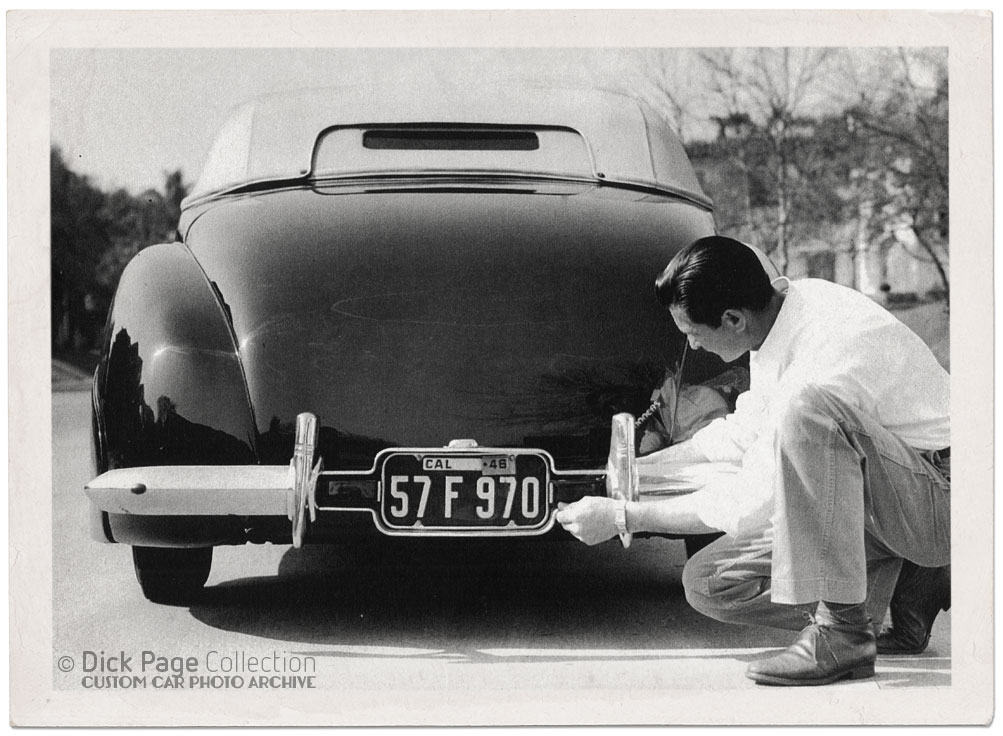
 Jimmy showing the rear bumper center, which he hand made to fit the 1941 Lincoln bumper ends. The shaped round bar follows the shape of the license plate, and next to the plate we can see the 1941 Ford taillights. Also very interesting in this photo, is that apparently Jimmy Summers had a name tag that he added to this, and possibly other cars he built. If you look carefully on the bottom of the trunk on the right side, behind the right bumper guard, you can read the letters “MMERS” in a fancy Art Deco font. This name tag can be seen in a few other photos as well, but none of the others show it this well.
Jimmy showing the rear bumper center, which he hand made to fit the 1941 Lincoln bumper ends. The shaped round bar follows the shape of the license plate, and next to the plate we can see the 1941 Ford taillights. Also very interesting in this photo, is that apparently Jimmy Summers had a name tag that he added to this, and possibly other cars he built. If you look carefully on the bottom of the trunk on the right side, behind the right bumper guard, you can read the letters “MMERS” in a fancy Art Deco font. This name tag can be seen in a few other photos as well, but none of the others show it this well.
[divider]
When Jimmy Summers built this car he had an every day driver in mind. Powered by a strong running Mercury V8, it was no sled, and certainly not a lead sled, as very little lead was used in its construction. Absolutely nothing was done to reduce ride, handling or drivability. Ground clearance of the car is rather good, as the running gear is still at factory height from the road.
Doane Spencer and Jimmy used to take long distance trips in this car, frequently joined by Spencer’s 1932 Ford Roadster. They would stop at Ford dealerships when money got low, Jimmy would do body work and Doane mechanical work for a week to raise some money, and then the went on the road again.
Over the years, the car has undergone many small changes, which helps identify when various photos were taken. The first hubcaps were the true “baby moons”, they were more pointed than today’s. The second set of hubcaps were a set of much flatter 1940 Ford hubcaps with the Ford letters removed, and flipper bars added. The third set of hubcaps where Lyon’s aftermarket caps. These Lyon’s were put on the car after Jimmy painted it green
The radio antenna also made its appearance in ’47, when the car was painted ’47 Buick Sherwood Green.
The car under went more changes in ’53 – including frenched headlights, set in license plate at the rear and molded hood center piece – All work done by Jimmy Summers. The car was then painted Ruby Maroon for the second time.

Dick Page tells: “in the late 50’s, Tex Roberts had Jimmy remove the interior door handles, and install those Hugh 6 volt GM starter solenoids. Tex had also installed a new black and white interior, and did not retain inside door handles. One fine day Tex, and his wife Herta on their way to dinner, dressed in their Sunday best in the parking lot of the officers club when… you guessed it, the relays or something went on strike… Well, Tex could never fit through the chopped side windows, Herta could …but not in a dress. So the rear zip-out back window flap of the Carson top was pressed into service. First Tex squeezed out, then caught Herta as she slid down the trunk lid. She made sure he installed emergency pull- cables for door latches starting the very next day.”
Sadly the Tex Roberts scrap book which hold a tremendous treasure of photos, and information on the car is lost.
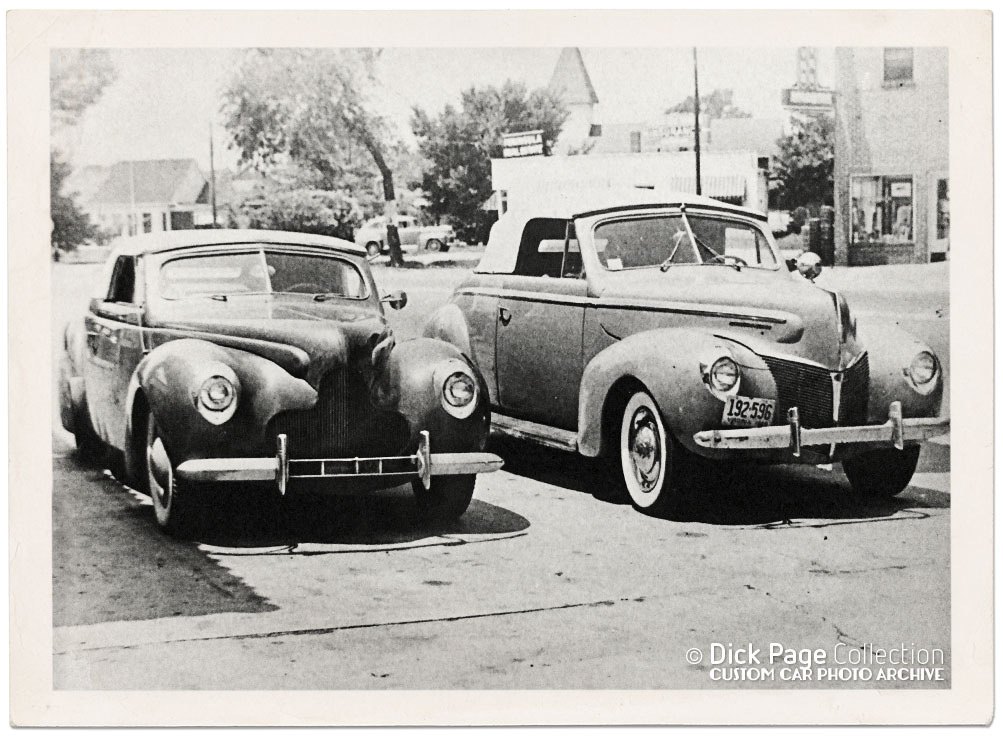 This nice photo from 1947 shows Jimmy’s Mercury sitting next to a stock 1940 Mercury Convertible. What a huge difference.
This nice photo from 1947 shows Jimmy’s Mercury sitting next to a stock 1940 Mercury Convertible. What a huge difference.
[divider]
Go to part one of the Jimmy Summers 1940 Mercury.
Go to part three of the Jimmy Summers 1940 Mercury.
[divider]
[divider]
(this article is sponsored by)
![]()



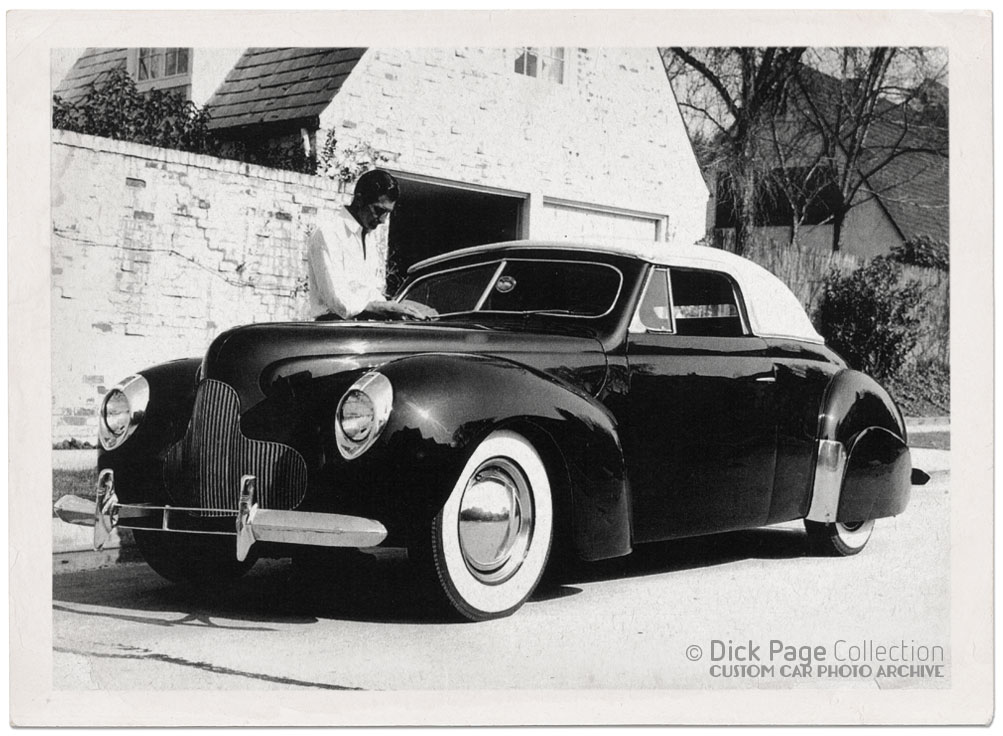


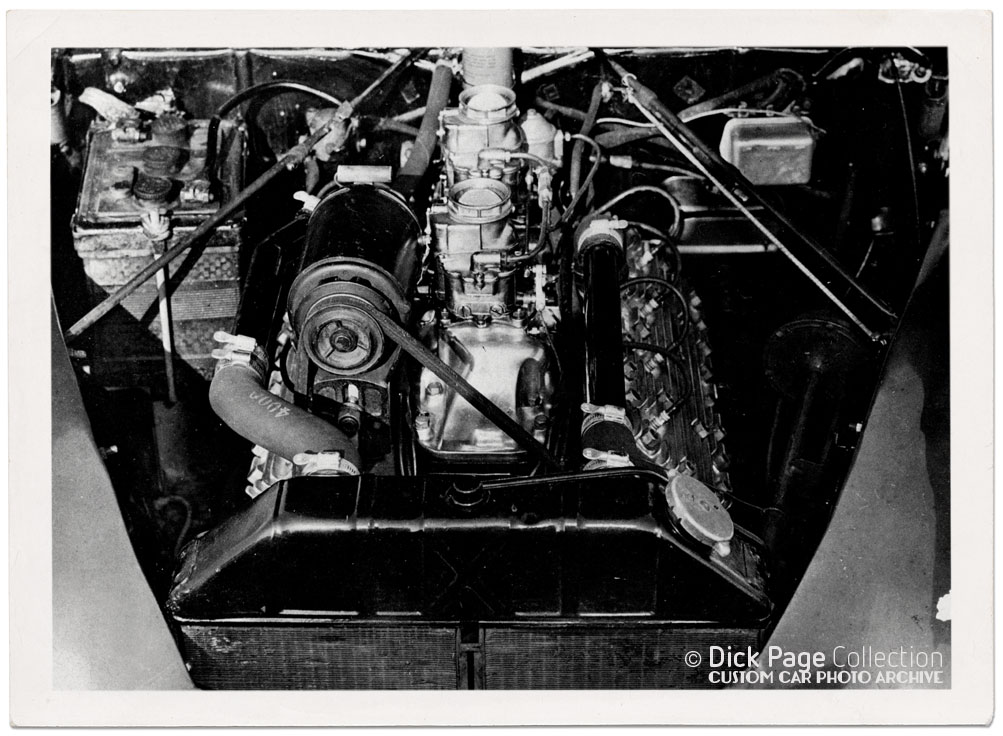





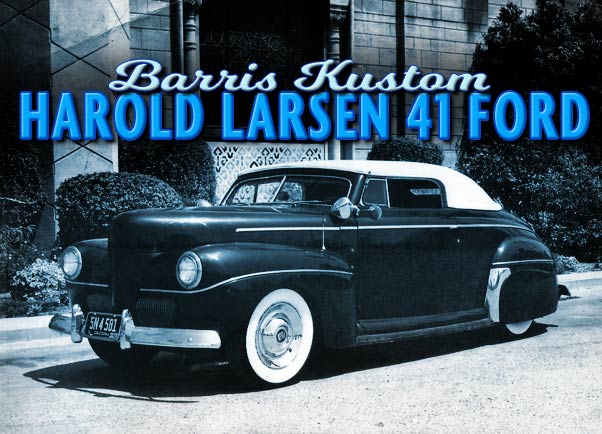

i have no idea how i missed those first two parts on that classy kustom !! thanks to the third part i found them, and it’s another fascinating story!